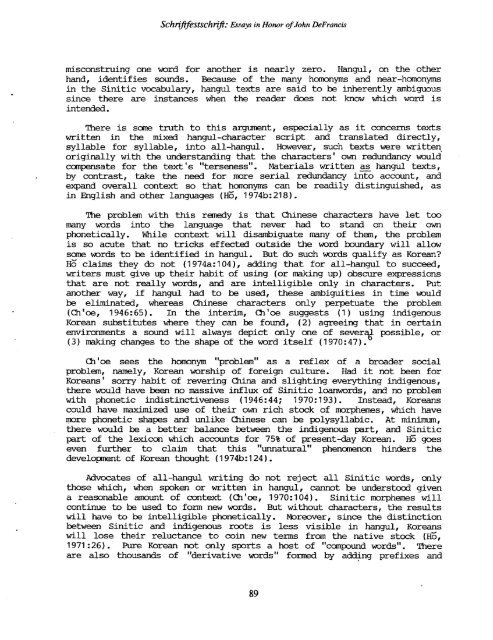Essays on Writing and Language in Honor - Sino-Platonic Papers
Essays on Writing and Language in Honor - Sino-Platonic Papers
Essays on Writing and Language in Honor - Sino-Platonic Papers
Create successful ePaper yourself
Turn your PDF publications into a flip-book with our unique Google optimized e-Paper software.
Schnfrfesestschriji: &says <strong>in</strong> H<strong>on</strong>or of John &Francis<br />
misc<strong>on</strong>stru<strong>in</strong>g <strong>on</strong>e mrd for another is nearly zero. Hangul, <strong>on</strong> the other<br />
h<strong>and</strong>, identifies sounds, Because of the many hom<strong>on</strong>yms <strong>and</strong> near-hom<strong>on</strong>yms<br />
<strong>in</strong> the S<strong>in</strong>itic vocabulary, hangul texts are said to be <strong>in</strong>herently ambiguous<br />
s<strong>in</strong>ce there are <strong>in</strong>stances when the reader does not know which word is<br />
<strong>in</strong>tended.<br />
There is some truth to this argument, especially as it c<strong>on</strong>cems texts<br />
written <strong>in</strong> the mixed hangul-character script <strong>and</strong> translated directly,<br />
syllable for syllable, <strong>in</strong>to all-hangul. However, such texts were written.<br />
orig<strong>in</strong>ally with the underst<strong>and</strong><strong>in</strong>g that the characters' own redundancy would<br />
canpemate for the text's "terseness". Materials written as hangul texts,<br />
by c<strong>on</strong>trast, take the need for more serial redundancy <strong>in</strong>s account, <strong>and</strong><br />
exp<strong>and</strong> overall c<strong>on</strong>text so that hom<strong>on</strong>yms can be readily dist<strong>in</strong>guished, as<br />
<strong>in</strong> English <strong>and</strong> other languages (5, 1974b:218).<br />
The problem with this remedy is that Ch<strong>in</strong>ese characters have let too<br />
many words <strong>in</strong>to the language that never had to st<strong>and</strong> <strong>on</strong> their own<br />
ph<strong>on</strong>etically. While c<strong>on</strong>text will disambiguate many of them, the problem<br />
is so acute that no tricks effected outside the word boundary will allow<br />
some mrds to be identified <strong>in</strong> hangul. But do such words qualify as Korean?<br />
HG claims they do not (1 974a: 1 04), add<strong>in</strong>g that for all-hangul to succeed,<br />
writers must give up their habit of us<strong>in</strong>g (or mak<strong>in</strong>g up) obscure expressi<strong>on</strong>s<br />
that are not really words, <strong>and</strong> are <strong>in</strong>telligible <strong>on</strong>ly <strong>in</strong> characters. Put<br />
another way, if hangul had to be used, these ambiguities <strong>in</strong> time would<br />
be elim<strong>in</strong>ated, whereas Ch<strong>in</strong>ese characters <strong>on</strong>ly perpetuate the problem<br />
(Ch'oe, 1946:65). In the <strong>in</strong>terim, Chloe suggests (1) us<strong>in</strong>g <strong>in</strong>digemus<br />
Korean substitutes where they can be found, (2) agree<strong>in</strong>g that <strong>in</strong> certa<strong>in</strong><br />
envir<strong>on</strong>ments a sound will always depict <strong>on</strong>ly <strong>on</strong>e of sever* possible, or<br />
(3) dc<strong>in</strong>g changes to the shape of the word itself (1970~47).<br />
aloe sees the hom<strong>on</strong>ym "problem" as a reflex of a broader social<br />
problem, namely, Korean worship of foreign culture. Had it not been for<br />
Koreans ' s<strong>on</strong>ry habit of rever<strong>in</strong>g Ch<strong>in</strong>a <strong>and</strong> slight<strong>in</strong>g everyth<strong>in</strong>g <strong>in</strong>digenous,<br />
there would have been no massive <strong>in</strong>flux of S<strong>in</strong>itic loanwords, <strong>and</strong> no problem<br />
with ph<strong>on</strong>etic <strong>in</strong>dist<strong>in</strong>ctiveness (1946:44; 1970:193). Instead, Koreans<br />
could have maximized use of their own rich stock of morphemes, which have<br />
mre ph<strong>on</strong>etic shapes <strong>and</strong> unlike Ql<strong>in</strong>ese can be polysyllabic. At m<strong>in</strong>imum,<br />
there would be a better balance between the <strong>in</strong>digenous part, <strong>and</strong> S<strong>in</strong>itic<br />
part of the lexic<strong>on</strong> which accounts for 75% of present-day Korean. HE goes<br />
even f w to claim that this "unnatural" phenomen<strong>on</strong> h<strong>in</strong>ders the<br />
development of Korean thought (1974b:124).<br />
Advocates of all-hangul writ<strong>in</strong>g do not reject all S<strong>in</strong>itic words, <strong>on</strong>ly<br />
those which, when spoken or written <strong>in</strong> hangul, cannot be understood given<br />
a reas<strong>on</strong>able amount of c<strong>on</strong>text (Chloe, 1970:104). S<strong>in</strong>itic morphemes will<br />
c<strong>on</strong>t<strong>in</strong>ue to be used to form new words. But without characters, the results<br />
will have to be <strong>in</strong>telligible ph<strong>on</strong>etically, Pbreover, s<strong>in</strong>ce the dist<strong>in</strong>cti<strong>on</strong><br />
between S<strong>in</strong>itic <strong>and</strong> <strong>in</strong>digenous roots is less visible <strong>in</strong> hangul, Koreans<br />
will lose their reluctance to co<strong>in</strong> new terms from the native stock (HG,<br />
1971 :26). Pure Korean not <strong>on</strong>ly sports a host of "compound words". There<br />
are also thous<strong>and</strong>s of "derivative words" formed by add<strong>in</strong>g prefixes <strong>and</strong>

















